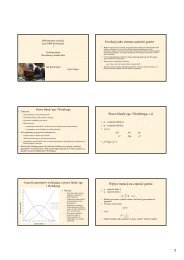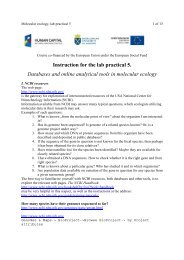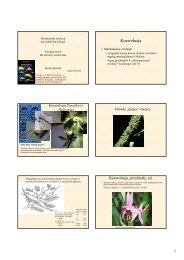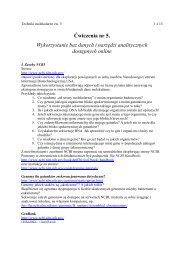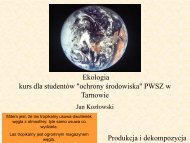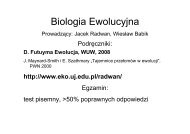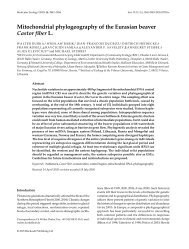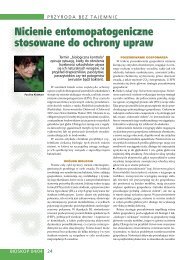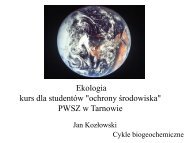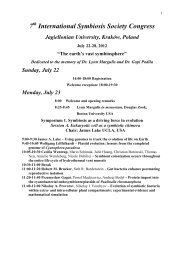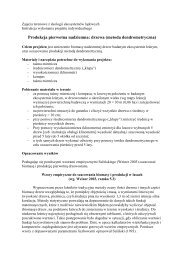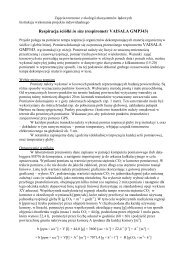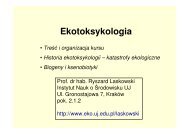Strong association between a single gene and fertilization efficiency ...
Strong association between a single gene and fertilization efficiency ...
Strong association between a single gene and fertilization efficiency ...
Create successful ePaper yourself
Turn your PDF publications into a flip-book with our unique Google optimized e-Paper software.
PGDH <strong>and</strong> sperm competition M. Konior <strong>and</strong> others 313<br />
they influence female fecundity by other means remains to<br />
be investigated.<br />
In conclusion, our study reveals that a <strong>single</strong> <strong>gene</strong>tic<br />
element, Pgdh itself, or one or more <strong>gene</strong>s in very strong<br />
gametic disequilibrium with the locus Pgdh, influence(s)<br />
both the <strong>fertilization</strong> <strong>efficiency</strong> of males <strong>and</strong> the fecundity<br />
of females mated with males of alternative genotypes.<br />
Importantly, while the Pgdh SS genotype confers a greater<br />
<strong>fertilization</strong> <strong>efficiency</strong> to males it also reduces the<br />
fecundity of females that mated with such males. Thus,<br />
the positive selection acting on SS males in the process of<br />
sperm competition is partly opposed by the selection<br />
arising through the decreased fecundity of their mates.<br />
The balance <strong>between</strong> the magnitude of these two selection<br />
forces will depend on the level of promiscuity. Because the<br />
level of promiscuity <strong>and</strong> sperm competition is probably<br />
higher under our laboratory conditions than in the wild<br />
(Radwan & Siva-Jothy 1996) this may lead to a relative<br />
increase of the selective effect through sperm competition<br />
<strong>and</strong> a disruption of the conditions allowing polymorphism<br />
to be maintained at Pgdh. Consistent with this prediction<br />
we observed a significant decline in the proportion of FF<br />
genotypes under laboratory conditions. However, it is also<br />
possible that other, unidentified selective forces acting on<br />
Pgdh in the field were absent or less important under<br />
laboratory conditions, hence accounting for the S allele<br />
having spread to fixation in the laboratory. More <strong>gene</strong>rally,<br />
our study adds to the increasing number of instances<br />
showing that protein <strong>and</strong> enzymatic variants can<br />
influence important components of fitness in the wild<br />
(e.g. Watt et al. 1985; Watt 1992; Merçot et al. 1994;<br />
Lenorm<strong>and</strong> et al. 1999; Ward 2000; Mauricio et al. 2003;<br />
Hoekstra et al. 2004) or even social behaviour (Keller &<br />
Ross 1998; Krieger & Ross 2002; Coates & de Bono<br />
2002).<br />
We thank Dave Hosken <strong>and</strong> two anonymous reviewers for<br />
their useful comments on the manuscript. This work was<br />
supported by the State Committee for Scientific Research<br />
KBN 0408/P04/2001 <strong>and</strong> the Swiss NSF.<br />
REFERENCES<br />
Bernasconi, G. & Keller, L. 2001 Female poly<strong>and</strong>ry affects<br />
their sons’ reproductive success in the red flour beetle<br />
Tribolium castaneum. J. Evol. Biol. 14, 186–193. (doi:10.<br />
1046/j.1420-9101.2001.00247.x)<br />
Birkhead, T. R. & Møller, A. P. 1998 Sperm competition <strong>and</strong><br />
sexual selection. London: Academic Press.<br />
Cavener, D. R. & Clegg, M. T. 1981 Evidence for<br />
biochemical <strong>and</strong> physiological differences <strong>between</strong> enzyme<br />
genotypes in Drosophila melanogaster. Proc. Natl Acad Sci.<br />
USA 78, 4444–4447.<br />
Chapman, T., Liddie, L. F., Kalb, J. M., Wolfner, M. F. &<br />
Partridge, L. 1995 Cost of mating in Drosophila melanogaster<br />
females is mediated by male accessory gl<strong>and</strong><br />
products. Nature 373, 241–244. (doi:10.1038/373241a0)<br />
Clark, A. G., Aguade, M., Prout, T., Harshman, L. G. &<br />
Langley, C. H. 1995 Variation in sperm displacement <strong>and</strong><br />
its <strong>association</strong> with accessory gl<strong>and</strong> protein loci in<br />
Drosophila melanogaster. Genetics 139, 189–201.<br />
Clark, A. G., Begun, D. J. & Prout, T. 1999 Female ! male<br />
interactions in Drosophila sperm competition. Science 283,<br />
217–220.<br />
Coates, J. C. & de Bono, M. 2002 Antagonistic pathways in<br />
neurons exposed to body fluid regulate social feeding in<br />
Caenorhabditis elegans. Nature 419, 925–929. (doi:10.<br />
1038/nature01170)<br />
Conte, R., Nodari, R. O., Vencovsky, R. & dos Reis, M. S.<br />
2003 Genetic diversity <strong>and</strong> recruitment of the tropical<br />
palm, Euterpe edulis Mart., in a natural population from<br />
the Brazilian Atlantic Forest. Heredity 91, 401–406.<br />
(doi:10.1038/sj.hdy.6800347)<br />
Cordero, A. & Miller, P. L. 1992 Sperm transfer, displacement<br />
<strong>and</strong> precedence in Ischnura graellsii (Odonata,<br />
Coenagrionidae). Behav. Ecol. Sociobiol. 30, 261–267.<br />
(doi:10.1007/BF00166711)<br />
Drnevich, J. M., Reedy, M. M., Ruedi, E. A., Rodriguez-Zas,<br />
S. & Hughes, K. A. 2004 Quantitative evolutionary<br />
genomics: differential <strong>gene</strong> expression <strong>and</strong> male reproductive<br />
success in Drosophila melanogaster. Proc. R. Soc. B<br />
271, 2267–2273. (doi:10.1098/rspb.2004.2880)<br />
Droney, D. C. 2003 Females lay fewer eggs for males with<br />
greater courtship success in a lekking Drosophila. Anim.<br />
Behav. 65, 371–378. (doi:10.1006/anbe.2003.2056)<br />
Friberg, U. & Arnqvist, G. 2003 Fitness effects of female mate<br />
choice: preferred males are detrimental for Drosophila<br />
melanogaster females. J. Evol. Biol. 16, 797–811. (doi:10.<br />
1046/j.1420-9101.2003.00597.x)<br />
Gavrilets, S., Arnqvist, G. & Friberg, U. 2001 The evolution<br />
of female mate choice by sexual conflict. Proc. R. Soc. B<br />
268, 531–539. (doi:10.1098/rspb.2000.1382)<br />
Hoekstra, H. E., Drumm, K. E. & Nachman, M. W. 2004<br />
Ecological <strong>gene</strong>tics of adaptive color polymorphism in<br />
pocket mice: geographic variation in selected <strong>and</strong> neutral<br />
<strong>gene</strong>s. Evolution 58, 1329–1341.<br />
Holl<strong>and</strong>, B. & Rice, W. R. 1998 Chase-away sexual selection:<br />
antagonistic seduction versus resistance. Evolution 52, 1–7.<br />
Holl<strong>and</strong>, B. & Rice, W. R. 1999 Experimental removal of<br />
sexual selection reverses intersexual antagonistic coevolution<br />
<strong>and</strong> removes a reproductive load. Proc. Natl Acad. Sci.<br />
USA 96, 5083–5088. (doi:10.1073/pnas.96.9.5083)<br />
Hosken, D. J., Garner, T. W. J. & Ward, P. I. 2001 Sexual<br />
conflict selects for male <strong>and</strong> female reproductive characters.<br />
Curr. Biol. 11, 489–493. (doi:10.1016/S0960-<br />
9822(01)00146-4)<br />
Keller, L. & Reeve, H. K. 1995 Why do females mate with<br />
multiple males? The sexually selected sperm hypothesis.<br />
Adv. Stud. Behav. 24, 291–315.<br />
Keller, L. & Ross, K. G. 1998 Selfish <strong>gene</strong>s: a green beard in<br />
the red fire ant. Nature 394, 573–575. (doi:10.1038/<br />
29064)<br />
Kirby, J. D. & Froman, D. P. 1991 Comparative metabolism<br />
of spermatozoa from subfertile Delaware <strong>and</strong> Wy<strong>and</strong>otte<br />
roosters. J. Reprod. Fertil. 91, 125–130.<br />
Kołodziejczyk, M. & Radwan, J. 2003 The effect of mating<br />
frequency on female lifetime fecundity in the bulb mite,<br />
Rhizoglyphus robini (Acari: Acaridae). Behav. Ecol. Sociobiol.<br />
53, 110–115.<br />
Kołodziejczyk, M., Heinze, J. & Radwan, J. 2002 Enzyme<br />
polymorphisms in Rhizoglyphus robini <strong>and</strong> R. echinopus <strong>and</strong><br />
their application in paternity analysis. Exp. Appl. Acarol.<br />
26, 161–168. (doi:10.1023/A:1021193411454)<br />
Konior, M., Radwan, J. & Kołodziejczyk, M. 2001 Poly<strong>and</strong>ry<br />
increases offspring fecundity in the bulb mite. Evolution<br />
55, 1893–1896.<br />
Konior, M., Keller, L. & Radwan, J. 2005 Effect of<br />
inbreeding <strong>and</strong> heritability of sperm competition success<br />
in the bulb mite Rhizoglyphus robini. Heredity 94, 577–581.<br />
Kozielska, M., Krzemińska, A. & Radwan, J. 2004 Good<br />
<strong>gene</strong>s <strong>and</strong> the maternal effects of poly<strong>and</strong>ry on offspring<br />
reproductive success in the bulb mite. Proc. R. Soc. B 271,<br />
165–170. (doi:10.1098/rspb.2003.2585)<br />
Proc. R. Soc. B (2006)



